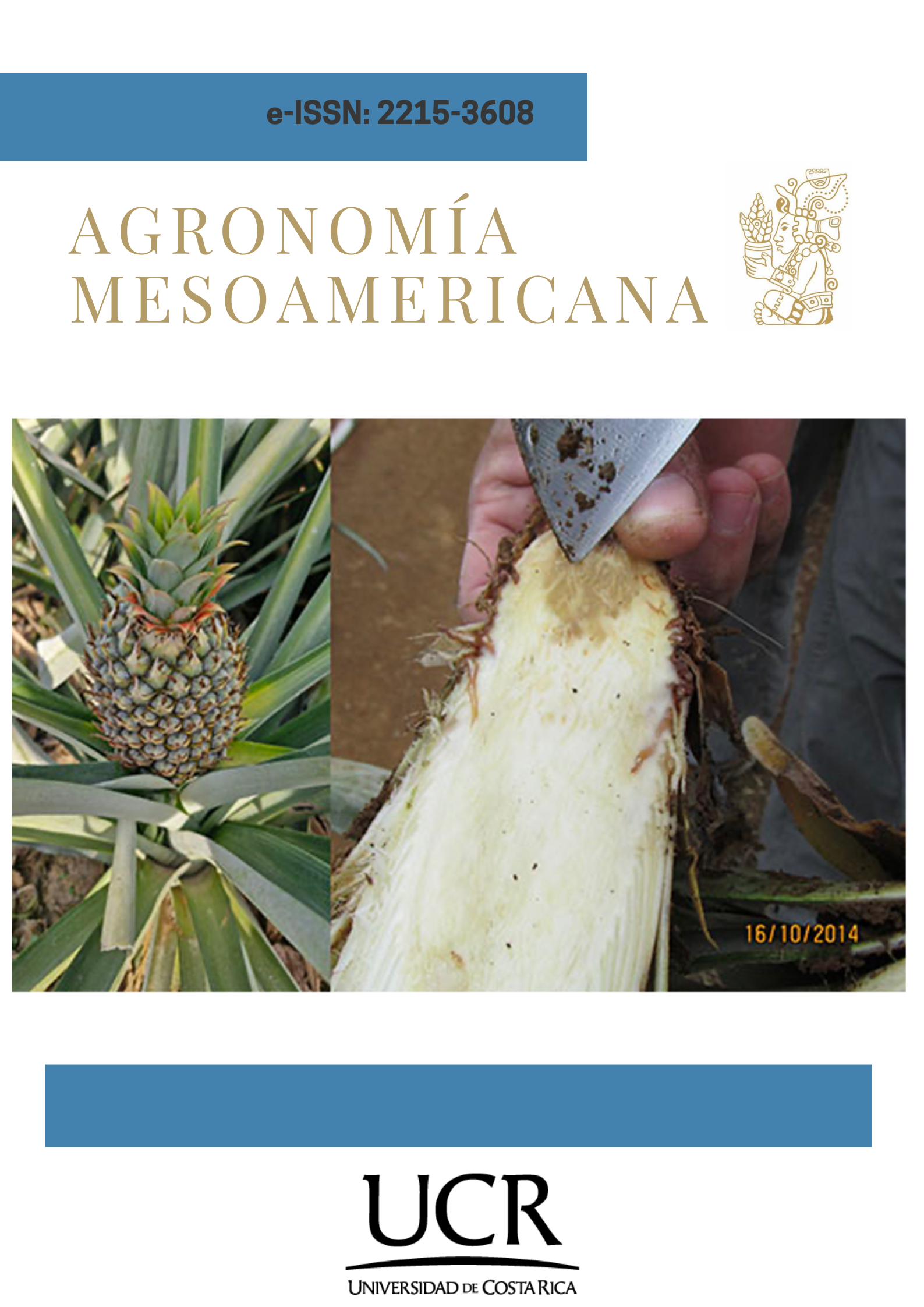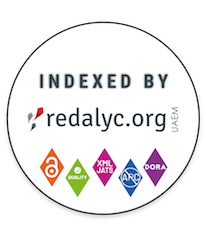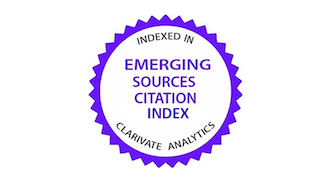Pathogenicity and frequency of Fusarium species associated with the pineapple plant and fruit in Costa Rica
DOI:
https://doi.org/10.15517/am.2025.60796Keywords:
Ananas comosus, postharvest diseases, molds, phytopathologyAbstract
Introduction. Costa Rica ranks among the world’s leading producers and exporters of pineapple; however, production and post-harvest handling are hampered due to phytosanitary problems caused by fungi of the genus Fusarium. Objective. To determine the pathogenicity of different Fusarium species associated with the pineapple plant and fruit, and their frequency in the main production areas of Costa Rica. Materials and methods. The experiments were conducted at the University of Costa Rica, San Jose, from 2015 to 2019. Pathogenicity tests were carried out using inoculation with six Fusarium species in bracts, peduncles, and fruits of pineapple, and were verified using Koch’s postulates. Through the collection of 120 isolates, the frequency of Fusarium species in the production areas was established. Results. All Fusarium species caused damage to bracts. The largest lesions were caused by F. oxysporum. In fruit, internal lesions were observed in the pulp with F. ananatum, and a correlation between lesion size and the concentration of inoculated conidia was found. In the peduncle and pulp, lesion diameter varied among Fusarium species. In terms of species frequency, all Fusarium species were present in the Huetar Norte region, and F. ananatum was more abundant in all production regions, except the Brunca region. Conclusions. All the species analyzed were pathogenic in the pineapple crop, in bracts, peduncles, and fruit. F. oxysporum and F. ananatum caused the greatest lesions. The presence in all pineapple-growing regions, the pathogenic potential, and the production of mycotoxins determine the importance of taking precise measures to control and prevent the spread of species from this genus.
Downloads
References
Barral, B., Chillet, M., Doizy, A., Grassi, M., Ragot, L., Léchaudel, M., Durand, N., Rose, L. J., Viljoen, A., & Schorr-Galindo, S. (2020). Diversity and toxigenicity of fungi that cause pineapple fruitlet core rot. Toxins, 12(5), Article 339. https://doi.org/10.3390/toxins12050339
Barral, B., Chillet, M., Léchaudel, M., Lartaud, M., Verdeil, J.-L., Conéjéro, G., & Schorr-Galindo, S. (2019). An imaging approach to identify mechanisms of resistance to pineapple fruitlet core rot. Frontiers in Plant Science, 10, Article 1065. https://doi.org/10.3389/fpls.2019.01065
Barral, B., Chillet, M. Minier, J., Léchaudel, M., & Schorr-Galindo, S. (2017). Evaluating the response to Fusarium ananatum inoculation and antifungal activity of phenolic acids in pineapple. Fungal Biology, 121(12), 1045–1053. https://doi.org/10.1016/j.funbio.2017.09.002
Blanco-Meneses, M., Castro-Zúñiga, O., & Umaña-Rojas, G. (2022). Estudio preliminar de especies de Fusarium presentes en piña (Ananas comosus) en Costa Rica. Agronomía Costarricense, 46(1), 47–64. https://doi.org/10.15517/rac.v46i1.49867
Borrás, O., Santos, R., Matos, A. P., Cabral, R. S., & Arzola, M. (2001). A first attempt to use a Fusarium subglutinans culture filtrate for the selection of pineapple cultivars resistant to fusariose disease. Plant Breeding, 120(5), 435–438. https://doi.org/10.1046/j.1439-0523.2001.00626.x
Cámara Nacional de Productores y Exportadores de Piña. (2023). Estadísticas. https://canapep.com/estadisticas/
Cano-Reinoso, D. M., Soesanto, L., Kharisun, K., & Wibowo, C. (2021). Review: Fruit collapse and heart rot disease in pineapple: pathogen characterization, ultrastructure infections of plant and cell mechanism resistance. Biodiversitas, 22(5), 2477–2488. https://doi.org/10.13057/biodiv/d220504
Castro Chinchilla, J., & Umaña Rojas, G. (2015). Poblaciones e identificación de los hongos causantes de mohos poscosecha en el pedúnculo de la piña, en dos zonas de Costa Rica. Agronomía Costarricense, 39(3), 61–77. https://doi.org/10.15517/rac.v39i3.21792
Castro Chinchilla, J., & Umaña Rojas, G. (2017). Frecuencia de los hongos asociados al desarrollo de mohos poscosecha en el pedúnculo de la piña en dos zonas de Costa Rica. Agronomía Costarricense, 41(2), 17–25. https://doi.org/10.15517/rac.v41i2.31296
Chen, L. Y., VanBuren, R., Paris, M., Zhou, H., Zhang, X., Wai, C. M., Yan, H., Chen, S., Alonge, M., Ramakrishnan, S., Liao, Z., Liu, J., Lin, J., Yue, J., Fatima, M., Lin, Z., Zhang, J., Huang, L., Wang, H., … Ming, R. (2019). The bracteatus pineapple genome and domestication of clonally propagated crops. Nature Genetics, 51, 1549–1558. https://doi.org/10.1038/s41588-019-0506-8
de Lira Júnior, J. S., Guimarães Tavares de Andrade, D. E., Fernandes Bezerra, J. E., dos Santos Assunção, M., de Assis, T. C., Junghans, D. T., & Pires de Matos, A. (2023). Selection of F1 genotypes of pineapple and reaction to inoculation with a Fusarium guttiforme isolate. Crop Breeding and Applied Biotechnology, 23(1), Article e43202315. http://dx.doi.org/10.1590/1984-70332023v23n1a5
de Matos, A. P., Mourichon, X., & Pinon, A. (1992). Occurrence of Fusarium moniliforme var. subglutinans on pineapple in Bolivia. Fruits, 47(1), 33.
Dianese, J. C., Bolkan, H. A., da Silva, C. B. & Couto, F. A. A. (1981). Pathogenicity of epiphytic population of Fusarium moniliforme var. subglutinans pathogenic to pineapple. Phytopathology, 71, 1145–1149. https://doi.org/10.1094/Phyto-71-1145
Di Rienzo, J. A., Casanoves, F., Balzarini, M. G., González, L., Tablada, M., & Robledo, C. W. (2020). InfoStat (Versión 2020). Centro de Transferencia InfoStat, Universidad Nacional de Córdoba. http://www.infostat.com.ar
Di Rienzo, J. A., Guzmán, A. W., & Casanoves, F. (2002). A multiple-comparisons method based on the distribution of the root node distance of a binary tree. Journal of Agricultural, Biological, and Environmental Statistics, 7(2), 129–142. http://www.jstor.org/stable/1400690
Fournier, P., Benneveau, A., Hardy, C., Chillet, M., & Lechaudel, M. (2015). A predictive model based on a pluviothermic index for leathery pocket and fruitlet core rot of pineapple cv. ‘Queen’. European Journal of Plant Pathology, 142, 449–460. https://doi.org/10.1007/s10658-015-0625-8
French, E., & Herbert, T. (1980). Métodos de investigación fitopatológica. Editorial IICA.
Gu, H., Zhan, R.-L., Zhang, L.-B., Gong, D.-Q., & Jia, Z.-W. (2015). First report of Fusarium ananatum causing pineapple fruitlet core rot in China. Plant Disease, 99(11), Article 1653. https://doi.org/10.1094/PDIS-03-15-0279-PDN
Hof, H. (2008). Mycotoxins: pathogenicity factors or virulence factors? Mycoses, 51(2), 93–94. https://doi.org/10.1111/j.1439-0507.2007.01455.x
Ibrahim, N. F., Mohd, M. H., Izham-Mohamed, N. M., & Zakaria, L. (2020). Mycotoxigenic potential of Fusarium species associated with pineapple diseases. Archives of Phytopathology and Plant Protection, 53(5-6), 217–229. https://doi.org/10.1080/03235408.2020.1736971
Ibrahim, N. F., Mohd, M. H., Izham-Mohamed, N. M., & Zakaria, L. (2016a). Fusarium fujikuroi causing fusariosis of pineapple in peninsular Malaysia. Australasian Plant Disease Notes, 11, article 21. https://doi.org/10.1007/s13314-016-0206-5
Ibrahim, N. F., Mohd, M. H., Mohamed Nor, N. M. I., & Zakaria, L. (2016b). Pathogenicity of Fusarium semitectum and Fusarium chlamydosporum associated with pineapple fusariosis. Malaysian Journal of Microbiology, 12(2), 164–170. http://dx.doi.org/10.21161/mjm.78115
Ibrahim, N. F., Mohd, M. H., Nor, N. M. I. M., & Zakaria, L. (2015). First report of Fusarium oxysporum and F. solani associated with pineapple rot in Peninsular Malaysia. Plant Disease, 99(11), Article 1650. https://doi.org/10.1094/PDIS-02-15-0227-PDN
Jacobs, A., Van Wyk, P. S., Marasas, W. F., Wingfield, B. D., Wingfield, M. J., & Coutinho, T. A. (2010). Fusarium ananatum sp. nov. in the Gibberella fujikuroi species complex from pineapples with fruit rot in South Africa. Fungal Biology, 114(7), 515–527. https://doi.org/10.1016/j.funbio.2010.03.013
Liang, Y. P., Lin, K. Y., Lai, S. Y., & Ni, H. F. (2024). Rapid identification and characterization of pineapple fruitlet core rot pathogens on the ‘TN20’ cultivar in Taiwan. European Journal of Plant Pathology, 168, 421–435. https://doi.org/10.1007/s10658-023-02770-4
Lim, T.-K., & Rohrbach, K. G. (1980). Role of Penicillium funiculosum strains in the development of pineapple fruit diseases. Phytopathology, 70, 663–665. https://doi.org/10.1094/Phyto-70-663
Ministerio de Agricultura y Ganadería. (2018, marzo). Prácticas efectivas para la reducción de impactos por eventos climáticos, cultivo de piña en Costa Rica. https://www.mag.go.cr/bibliotecavirtual/F01-8166.pdf
Monitoreo de Cambio de Uso en Paisajes Productivos. (s.f.). Cultivo de piña en Costa Rica. Actualizaciones al 2019 tras análisis en el 2022. Recuperada 19 de marzo, 2024, de https://mocupp.org/cultivo-pina/
Montealegre, J. R., & Luchsinger, L. E. (1990). Fungi associated to pineapple fruit rots marketed in Chile. Acta Horticulturae, 269, 515–518. https://doi.org/10.17660/ActaHortic.1990.269.67
Montoya-Martínez, A. C., Rodríguez-Alvarado, G., Fernández-Pavía, S. P., Proctor, R. H., Kim, H.-S., & O’Donnell, K. (2019). Design and validation of a robust multiplex polymerase chain reaction assay for MAT idiomorph within the Fusarium fujikuroi species complex. Mycologia, 111(5), 772–781. https://doi.org/10.1080/00275514.2019.1649956
Nirenberg, H. I., & O’Donnell, K. (1998). New Fusarium species and combinations within the Gibberella fujikuroi species complex. Mycologia, 90(3), 434–458. https://doi.org/10.2307/3761403
O’Donnell, K., Kistler, H. C., Cigelnik, E., & Ploetz, R. C. (1998). Multiple evolutionary origins of the fungus causing Panama disease of banana: concordant evidence from nuclear and mitochondrial gene genealogies. Proceedings of the National Academy of Sciences of the United States of America, 95(5), 2044–2049. https://doi.org/10.1073/pnas.95.5.2044
Organización de las Naciones Unidas para la Alimentación y la Agricultura. (2023). Principales frutas tropicales. Análisis del mercado 2022. https://www.fao.org/3/cc7108es/cc7108es.pdf
Pereira Arguedas, G. (2016). Indicadores de producción, cosecha y postcosecha en piña (Ananas comosus, var. Comosus) híbrido MD-2 en finca Exportaciones Norteñas, Río Cuarto de Grecia, 2016 [Tesis de licenciatura, Instituto Tecnológico de Costa Rica]. Repositorio TEC. https://repositoriotec.tec.ac.cr/handle/2238/13327
Petty, G. J., Tustin, H. A., & Dicks, H. M. (2006). Control of black spot disease/fruitlet core rot in Queen pineapple with integrated mealybug, pineapple fruit mite and fungus control programmes. Acta Horticulturae, 702, 143–149. https://doi.org/10.17660/ActaHortic.2006.702.17
Ratti, M. F., Ascunce, M. S., Landivar, J. J., & Goss, E. M. (2018). Pineapple heart rot isolates from Ecuador reveal a new genotype of Phytophthora nicotianae. Plant Pathology, 67(8), 1803–1813. https://doi.org/10.1111/ppa.12885
Rohrbach, K. G. (1994). Fusariosis. Phytopathological Society Press.
Rojas Valdiviezo, J. E. (2020). Aislamiento, patogenicidad y caracterización molecular de Fusarium oxysporum Schltdl, que afecta piña (Ananas comosus) en Poroto, La Libertad [Tesis de maestría, Universidad Nacional de Trujillo]. Repositorio de la Universidad de Trujillo, Perú. https://hdl.handle.net/20.500.14414/15813
Secretaría Ejecutiva de Planificación Sectorial Agropecuaria. (2023, marzo). Desempeño del sector agropecuario 2023. http://www.sepsa.go.cr/docs/2023-005-Desempenno_SectorAgro_2022.pdf
Singh, B. K., Delgado-Baquerizo, M., Egidi, E., Guirado, E., Leach, J. E., Liu, H., & Trivedi, P. (2023). Climate change impacts on plant pathogens, food security and paths forward. Nature Reviews Microbiology, 21, 640–656. https://doi.org/10.1038/s41579-023-00900-7
Stępień, L., Koczyk, G., & Waśkiewicz, A. (2011). Genetic and phenotypic variation of Fusarium proliferatum isolates from different host species. Journal of Applied Genetics, 52, 487–496. https://doi.org/10.1007/s13353-011-0059-8
Sweany, R. R., Breunig, M., Opoku, J., Clay, K., Spatafora, J. W., Drott, M. T., Baldwin, T. T., & Fountain, J. C. (2022). Why do plant-pathogenic fungi produce mycotoxins? Potential roles for mycotoxins in the plant ecosystem. Phytopathology, 112(10), 2044–2051. https://doi.org/10.1094/PHYTO-02-22-0053-SYM
Timmusk, S., Nevo, E., Ayele, F., Noe, S., & Niinemets, Ü. (2020). Fighting Fusarium pathogens in the era of climate change: a conceptual approach. Pathogens, 9(6), Article 419. https://doi.org/10.3390/pathogens9060419
Vásquez Jiménez, J. (2009). Evaluación de la eficacia in vitro de sustancias químicas y microorganismos antagónicos del género Trichoderma spp., como herramienta para la toma de decisiones en el control de enfermedades “caso muerte descendente del cultivo de piña Ananas comosus (L) Merr” [Tesis licenciatura, Instituto Tecnológico de Costa Rica]. Repositorio TEC. https://repositoriotec.tec.ac.cr/handle/2238/4004
Vásquez Jiménez, J., & Mata Granados, X. (2014). Diagnosis of Fusarium oxysporum in the cultivation of pineapple Ananas comosus (L.) Merr. Net Journal of Agricultural Science, 2(3), 107–112. https://www.netjournals.org/pdf/NJAS/2014/3/14-035.pdf
Ventura, J. A., Costa, H., Cabral, J. R. S., & De Matos, A. P. (2009). ‘Vitória’: new pineapple cultivar resistant to Fusariosis. Acta Horticulturae, 822, 51–56. https://doi.org/10.17660/ActaHortic.2009.822.4
Vignassa, M., Meile, J.-C., Chiroleu, F., Soria, C., Leneveu-Jenvrin, C., Schorr-Galindo, S., & Chillet, M. (2021). Pineapple mycobiome related to fruitlet core rot occurrence and the influence of fungal species dispersion patterns. Journal of Fungi, 7(3), Article 175. https://doi.org/10.3390/jof7030175
White, T. J., Bruns, T., Lee, S., & Taylor, J. (1990). Amplificación y secuenciación directa de genes de ARN ribosómico fúngico para filogenética. En M. A. Innis, D. H. Gelfand, J. J. Sninsky, & T. J. White (Eds.), Protocolos de PCR: Una guía de métodos y aplicaciones (pp. 315–324) . Academic Press, Inc.
Wills, R., McGlasson, B., Graham, D., & Joyce, D. (1998). Introducción a la fisiología y manipulación poscosecha de frutas, hortalizas y plantas ornamentales. Acribia.
Zakaria, L. (2023). Fusarium species associated with diseases of major tropical fruit crops. Horticulturae, 9(3), Article 322. https://doi.org/10.3390/horticulturae9030322
Zhang, Y., Ma, H. Y., Liu, S. H., Hu, H. Q., Ren, L., & Wang, Y. Y. (2024). First report of leaf spot disease on pineapple caused by Fusarium solani in China. Plant Disease, 108(2), Article 528. https://doi.org/10.1094/PDIS-09-23-1791-PDN

Downloads
Additional Files
Published
How to Cite
Issue
Section
License
Copyright (c) 2025 María Díaz-Gutiérrez, Oscar Castro-Zúñiga, Gerardina Umaña-Rojas, Valery Webb, Mónica Blanco-Meneses

This work is licensed under a Creative Commons Attribution-NonCommercial-NoDerivatives 4.0 International License.
1. Proposed policy for open access journals
Authors who publish in this journal accept the following conditions:
a. Authors retain the copyright and assign to the journal the right to the first publication, with the work registered under the attribution, non-commercial and no-derivative license from Creative Commons, which allows third parties to use what has been published as long as they mention the authorship of the work and upon first publication in this journal, the work may not be used for commercial purposes and the publications may not be used to remix, transform or create another work.
b. Authors may enter into additional independent contractual arrangements for the non-exclusive distribution of the version of the article published in this journal (e.g., including it in an institutional repository or publishing it in a book) provided that they clearly indicate that the work was first published in this journal.
c. Authors are permitted and encouraged to publish their work on the Internet (e.g. on institutional or personal pages) before and during the review and publication process, as it may lead to productive exchanges and faster and wider dissemination of published work (see The Effect of Open Access).























